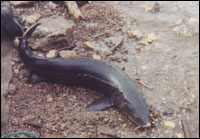Every winter, on the outskirts of Appleton, Wis., the world’s strangest subdivision suddenly appears. Thousands of shacks, each about the size of a two-hole outhouse, proliferate on the frozen expanse of Lake Winnebago.
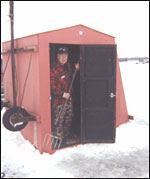
Dick Koerner in his shack
on Lake Winnebago.
Photo: Erik Ness.
Early in the morning on Feb. 8, Dick Koerner jockeyed his pickup along the frozen track to his weather-beaten shelter. He unloaded his truck and unlocked the shack. The windowless, flat-black interior accentuated the glorious green light flowing from a rectangular hole cut in the ice. Koerner closed the door, completing the immersion in that transfixing light, then cleared the hole of ice shards, hung a decoy, and readied his spear: four feet long with a small and nasty head shaped like a pitchfork. He suspended it above the hole, then sat, as he has done every winter save two since 1953, and waited for a really big fish.
Welcome to the surreally patient world of sturgeon spearing, whose adherents regularly go decades without seeing a single fish. The hut is a close approximation of a sensory-deprivation chamber. Luminescent as it is, the hole looks like nothing so much as a plasma-screen television set flush into the floor. And truly, there is nothing on TV.
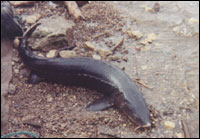
Sturgeon for action.
Photo: Erik Ness.
“You get all your meditation done,” says Koerner. “It’s like sitting in front of an aquarium for six hours. An empty aquarium.” Spearers have been known to nod off and tumble into their hole. The odds of catching a fish? Well, lie on your back, point a rifle up your chimney, and wait for a duck to fly by.
Zen jokes aside, the formidable spear leaves no question that this is a blood sport, with all the associated adrenaline and testosterone. But if the spearing seems brutal, note this: While most of the world’s 25 species of sturgeon are rare or endangered, there are more sturgeon in and around Lake Winnebago than anywhere on the planet. Once, sturgeon were poached at will from upstream rivers, packed illicitly in coffins, and shipped to Chicago by boxcar. Now, every spring, hundreds of people — many of them spearers — join the Sturgeon Guard, the volunteer army dedicated to protecting the helpless, spawning sturgeon from would-be poachers.
Caviar Emptor
As is so often the case in the natural world, sex and appetite lie at the heart of the sturgeon’s troubles. Sturgeon eggs, teased from the ovarian membrane and pickled in brine, are sold as caviar, a delicacy and also a reputed aphrodisiac. Up to one-fifth of the weight of a mature female can be eggs, and at $150 a pound, the poaching temptation is significant. In Brooklyn in early May, just after the Wisconsin spawn ended, Arkady Panchernikov, a 53-year-old Russian immigrant and this country’s largest caviar dealer, was fined $400,000 and sentenced to 21 months in prison for trading in ill-gotten sturgeon caviar. A few days later, California wildlife officers arrested eight people for poaching white sturgeon from the Sacramento River.
These are the forces the Sturgeon Guard is dedicated to fighting. In the 1970s and ’80s, careful management and lake cleanup efforts helped set the stage for a rebound of the Winnebago sturgeon population, estimated at a low of 11,500 in 1957. Ironically, though, the success of the sturgeon attracted potential poachers, and although wardens worked 12 hour shifts, they still couldn’t cover the terrain and adequately protect the species. In 1987, the state decided to ask for citizen volunteers, and the Sturgeon Guard was born. Under the program, which has become a model for others, volunteer guards are fed a meal at Fish Camp, issued a cell phone, and sent to spawning hot spots.
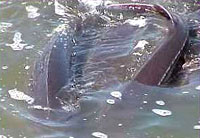
Spawned but not forgotten.
Photo: Wisconsin DNR.
The protection is needed because during spawning season, the fish are all but oblivious to anything but their primal urges; bystanders can literally reach down and pet them. Lake Winnebago sturgeon spawn upstream in the Wolf and Embarass rivers, swimming as many as 127 miles, past the town of Shiocton all the way to Shawano, to locate shallow, rocky shoals suitable for mating. The males, usually smaller and younger, swim in small packs. The spawning frenzy begins when a female arrives and scrapes against the rocks to release her eggs; the males, meanwhile, swarm about releasing milt, or sperm. Each act lasts about five seconds, but spawning activity for one female can last five to eight hours, and sometimes even into the next day. Few eggs survive; most are scarfed up right way by turtles and fish — even other sturgeon. Yet the Winnebago population is now conservatively estimated to number between 40,000 and 50,000 fish.
Poached Eggs
Poaching is still a sensitive topic in towns along the Wolf River. One Sturgeon General — the captain of the watch for the Sturgeon Guard — admits to kin whose legal relationship to the fish in their smoker may have been questionable. People still gossip nervously about coffin-filled railcars, shots fired on the river, and the so-called Shiocton Mafia.
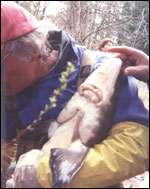
A sturgeon smiles for the camera.
Photo: Erik Ness.
Those days are hopefully past, thanks in part to the Sturgeon Guard. That’s only fitting, as humans are the only threat to a species that has outlasted the dinosaurs. The skin on the bodies of individuals in this 100 million-year-old species is like that of a shark — leathery, not scaly — as is their tail fin, which is longer on top than bottom and breaks the water in eerie shark-like fashion. Sturgeon share their primitive anatomy with the likes of the coelacanth, the so-called fossil fish whose live capture ignited a scientific firestorm in 1938. Individual sturgeon live long, and large. In 1881, one I. Pollack is said to have caught a nine-foot, 297-pounder at Lake Winnebago. Two 310 pound fish have been pulled from Great Lakes waters. All of these fish were probably at least 100 years old.
Fish of those dimensions are exceptionally rare, although during this year’s run a fishery team from the Wisconsin Department of Natural Resources nabbed an 82-inch fish, estimated at 130 pounds and 60 to 70 years of age. Appropriately, the crew was all volunteer — retired fisheries biologists who call themselves the Geriatric Crew. In charge of the team was Dan Folz, who began working with sturgeon back in 1959. “We came out of college and started working with fossil fish,” he joked. “Now we’re the living fossils.”
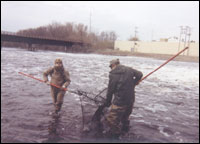
The Geriatric Crew at work below
the Shawano dam.
Photo: Erik Ness.
Taking in the crowd of curious folks watching the work, Folz recalled tougher times. He used to work with Gordon Priegel, the fish biologist who pioneered sturgeon research in Wisconsin. One night after midnight, the pair were tagging fish in the proximity of a local tavern. “Why don’t you take a break, Dan,” Priegel called from the riverbank. “Nah, I’m fine,” said Folz, his back to the boss. A few moments went by, and again Priegel suggested that Folz take a break. Again Folz declined, but again Priegel insisted. Finally, Folz relented and climbed the steep bank to find his boss surrounded by a surly crowd from the nearby tavern. The men had little interest in the scientific exploration of their prized fishing hole. They already knew how to take its measure. But first they had to go through Folz, 6’9″ and an athletic former center for the University of Wisconsin basketball team. One by one, the men walked up to Folz, puffed themselves to full height, and backed down again. Nobody dared take him on.
Nowadays, signs in Shiocton direct visitors to sturgeon viewing at Bamboo Bend just outside of town. Late last month, with the run ending and just a dozen fish still churning the shallows, a steady parade of visitors still kept turning off the highway to watch. A well-worn bumper sticker protested plans for a large gold and zinc mine upriver — plans held at bay with the help of the spearing community. Shiocton’s welcome sign now boasts the silhouette of a crane and a pleasant bit of hype: “Where nature begins.”
